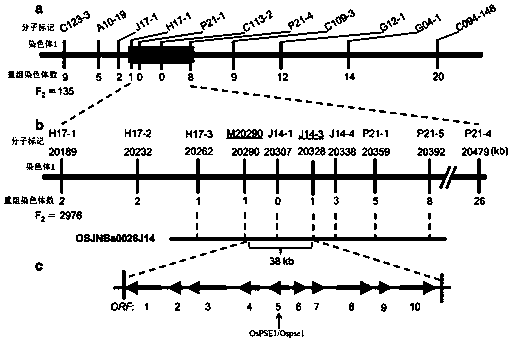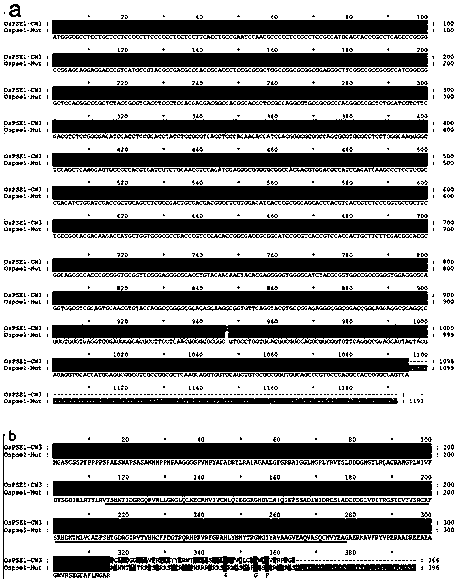ospse1 Application of genes in regulating plant senescence
A technology of plant senescence and transgenic plants, applied in the field of genetic engineering, can solve the problems of shortening the grain filling time in the leaf functional period, limiting the improvement of crop yield and quality, and reducing the accumulation of dry matter, so as to achieve good application potential, delay plant senescence, Increase the effect of accumulation
- Summary
- Abstract
- Description
- Claims
- Application Information
AI Technical Summary
Problems solved by technology
Method used
Image
Examples
Embodiment 1
[0031] Embodiment 1 rice senescence-related genes OsPSE1 / Ospse1 Construction of the electron physical map and screening of candidate genes
[0032] The present invention clones by map position cloning method OsPSE1 / Ospse1 Gene( figure 1 ).
[0033] The inventors obtained prematurely senescent rice plants during tissue culture Ospse1 , the inventor crossed the plant with the wild-type material CW312, and the obtained hybrid F 1 The phenotype of the generation plants was normal, indicating that the progeria gene was recessive relative to the normal gene. f 1 F 2 Generation population, count F from heading stage to fruiting stage 2 Number of wild-type and progeria individuals in population, progeria rice plants Ospse1 The segregation ratio with the wild-type material CW312 is 1:3, indicating that the premature aging phenotype is controlled by a pair of recessive genes.
[0034] prematurely senescent rice plants Ospse1 F 2 Separate groups for Ospse1 Genetic loca...
Embodiment 2
[0038] Example 2 OsPSE1 Genetic Complementation Vector and Overexpression Vector Transformed into Pregeriatric Plants of Rice Ospse1
[0039] According to the Nipponbare reference sequence, specific PCR primers including about 1 kb of the coding region and about 2.3 kb and 1.1 kb of the upstream and downstream regulatory regions were designed OsPSE1 -CT-F and OsPSE1 -CT-R (Table 2), using the high-fidelity enzyme KOD-Plus combined with long-range PCR (long-range PCR, LR-PCR) technology, using gDNA of wild-type CW312 as a template, amplified a target fragment of about 4.3 kb, and used restriction endonuclease Hin d III and Bam After HI cleavage, it was cloned into the plant binary vector pCAMBIA1300 (CAMBIA Company, Canberra, Australia) to obtain a genetic complementation vector.
[0040] Additionally designed to include candidate genes OsPSE1 Gene-specific primers for the entire ORF OsPSE1 -OE-F and OsPSE1 -OE-R (Table 2), PCR amplified CW312 genomic DNA to obtain a...
Embodiment 3
[0043] Embodiment 3 rice senescence-related genes OsPSE1 / Ospse1 Nucleotide sequence and protein structure
[0044] Amplified by PCR OsPSE1 and Ospse1 Genome sequence and sequencing, found rice premature senescence plant Ospse1 is in the wild type OsPSE1 A C base deletion occurred at the 947th bp of the coding region ( image 3 a), resulting in the extension of its coding region from 1095 bp to 1191 bp, and the encoded protein has a frameshift mutation from the point of mutation, OsPSE1 and Ospse1 The nucleotide sequences are shown in SEQ ID No: 1 and SEQ ID No: 3, respectively.
[0045] OsPSE1 and premature senescent plants Ospse1 The protein sequences are shown in SEQ ID No: 2 and SEQ ID No: 4, respectively. OsPSE1 It encodes a protein polypeptide consisting of 364 amino acid residues, with a molecular weight of about 39.5 kDa and an isoelectric point of 7.432; and Ospse1 It encodes a protein polypeptide consisting of 396 amino acid residues, with a molecular ...
PUM
| Property | Measurement | Unit |
|---|---|---|
| molecular weight | aaaaa | aaaaa |
| molecular weight | aaaaa | aaaaa |
Abstract
Description
Claims
Application Information
 Login to View More
Login to View More - R&D
- Intellectual Property
- Life Sciences
- Materials
- Tech Scout
- Unparalleled Data Quality
- Higher Quality Content
- 60% Fewer Hallucinations
Browse by: Latest US Patents, China's latest patents, Technical Efficacy Thesaurus, Application Domain, Technology Topic, Popular Technical Reports.
© 2025 PatSnap. All rights reserved.Legal|Privacy policy|Modern Slavery Act Transparency Statement|Sitemap|About US| Contact US: help@patsnap.com



